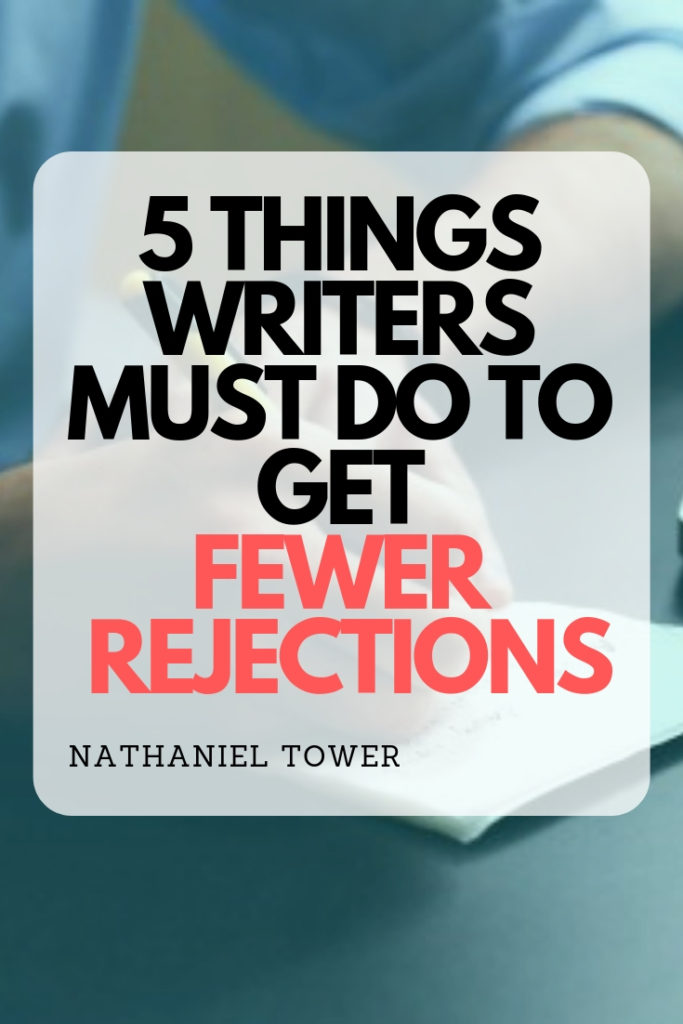Last Updated on June 2, 2020 by Nathaniel Tower
Ten years ago, I was a hotshot writer. Of course I was a hotshot. I was a writer. That not only made me a hotshot, but it also made me hot shit. As hot shit, I knew my stories should be published. So I bought a thick book that told me where to send my stories. And send my stories I did. For a year or two, I probably paid a full postal worker salary with my stamps.
But here’s where this gets funny. Nobody published my stories. Instead, they sent form rejections using the stamped envelopes I had stuffed into my submission packets. Turned out I wasn’t hot shit after all.
The thing is, I never bothered to read any of the magazines that I thought should publish my work. I had no clue what they wanted. I just knew they published stories. Some of them even paid to publish stories. I figured it would be easy money.
If only I had known a damn thing.
When my first publication finally came, it wasn’t from a snail mail submission, and it wasn’t by a venue I had found in that big stupid book. I had discovered something even better. I could email submissions out to lit mags. This meant I could send hundreds, even thousands, of submissions a year. My chances at becoming a rich and famous writer had just gone up exponentially.
What actually went up exponentially was my rejection rate. You see, I still wasn’t reading these publications. I was just throwing my work out there to anyone who would consider it. After all, I was destined to become that hotshot writer, and destiny operates purely on random chance.
I still didn’t know a damn thing.
I was technically a published writer, and I probably knew even less about being a writer. But I was growing tired of rejection, and I became determined to do something about it.
I continued writing. I started a lit mag. I changed my submission routine. I received more acceptances (and more rejections). I made some money. Things didn’t look so bad for me anymore.
To date, I’ve had over 200 stories published. But I’ve probably received well over 1,000 rejections. Many of them could have been avoided if I hadn’t been so foolish. Ultimately, I wasted a lot of my time—and a lot of other people’s time.
So how did I change my strategy and go from an oft-rejected failure to a frequently accepted pseudo-success? Here are a few of the adjustments I made to my submission process:

1. I did a better job tracking my submissions. I didn’t need to pay for any fancy writing tool. I created a relatively simple (and color-coded) spreadsheet that tracked everything.
2. I began reading and researching any market where I intended to submit. This meant a lot more than reading their guidelines. I tried to read at least a dozen stories from each lit mag. If I didn’t like the first few—or thought my writing didn’t jive with what they published—then I moved on. I never submitted to a place I didn’t like.
3. I came up with the rule of 5: never have the same story under consideration at more than 5 venues simultaneously. This saved a lot of time, especially when a piece did get accepted.
4. I stopped trying to conquer lit mags. I used to send story after story to the same lit mag, responding to each rejection with another piece ripe for rejection. In most cases, it’s foolish to try cracking a lit mag. If they don’t like your first seven stories, they probably won’t like your 37th either.
5. I sought relationships rather than one-issue stands. Instead of trying to land my work in as many publications as possible and then moving on, I started developing favorites—magazines I would not only read again and again, but magazines I would submit to again and again. Just be careful not to overstay your welcome. Most magazines want to publish more than just one writer.
And that’s about it. Nothing too drastic. Oh, I also spent more time editing before sending out my work, but that’s another story.
Of course, no matter what type of submission regimen you follow, there’s only one way to ensure you won’t be rejected: don’t submit. Writing will always be a matter of taste. If you want to get accepted, you have to deal with rejection no matter how carefully conceived your submission strategy is. But why not give yourself at least a fighting chance?
What else can writers do to improve the submission process? Share your thoughts in the comments.



I think point 2 is especially important. Writers seeking to be published have to work to understand the market that they’re trying to enter. Sending out submissions to literary magazines that don’t represent your type of work is a waste of both your time and theirs. Research is key.
Thank you for reading and commenting. I definitely agree with your point here. We could all benefit from wasting less time!
I often think I spend as much time researching markets as I do writing stories. It can be tedious and frustrating, but not as frustrating as rejection. It’s not foolproof, of course, but anything that improves my chances of publication is worth it. Along the way, I’ve enjoyed reading some great stories and in the process, hopefully, improved my own writing ability.
John, I know exactly how you feel. Finding the right venue can take a lot more time than creating the work. But when the story does get published in a suitable venue, it all becomes worth it (most of the time).
In a strange way, I envy your big book and SASEs. Obviously the internet has blown the market for publication wide open, increasing everyone’s chances of getting published. But the sheer number of ‘matches’ can be overwhelming. Even a search on Duotrope can lead you to 300+ possible matches. If you write old school, semi-literary character based meandering prose (raising hand), the only places that pay are the ones with acceptance rates of less than 2%. Reading, blogging, reading blogs, reading lit mags, researching markets, commenting on peer work, critiquing–it’s all good, solid advice. In between living, making sure the kids vaccines are up to date, your mother’s birthday card is in the mail, having clean sheets every now and again…sometimes I wonder when there is time to just write. That sounds horribly whiny I know, but it’s what I’ve been experiencing of late. (And I’m not even really submitting much at the moment, simply wondering how to fit it all in!)
Dina, thank you for reading and commenting. I definitely don’t miss the SASE days!
I also haven’t been submitting much lately. Life seems to be catching up with me.
Hi Dina, I know how you feel. I know it makes sense to read a mag before you send a piece out to them, but the numbers are stacked against writers. Reading one magazine a month seems to be a reasonable goal for someone with a day job, but that still means only 12 a year, and it’s hard to get published in your lifetime if you only submit to 12 places a year (and that’s assuming that all 12 you read happen to publish the type of stuff you write).
Great post! I would add that I think it’s also important to be honest about what kind of work your work is. We all want to believe that it will speak to everyone, but I’ve found I had a lot more success when I realized, hey, I write about the Southwest, maybe I should submit to a place that’s into that; this story is sort of feminist sci fi thing, maybe I should focus on a place that publishes that–rather than the big name lit mags that everyone is trying to conquer. They say gaining a readership is about finding your tribe, and your tribe may be small but mighty.
A few more thoughts on the process as it applies to the novel:
https://sdefreitastimmons.wordpress.com/2014/12/05/submit-yourself-what-i-learned-in-30-days-of-fiction-submissions/
Susan, that’s an excellent point. Knowing your voice and audience is another great way to improve your submission process. I think we often read magazines and think, “Oh yeah, my stories are as good as these stories.” But that’s not the right way of looking at it. We have to understand our own writing before we can understand where we should be sending it. Thanks for the addition to the list!
Post hoc theorizing is a bunch of BS. Hard work and throwing shit at the wall is probably the reason for your modest success. Sorry.
Mark Twain, thanks for reading and commenting (even if you don’t agree with what I’ve said here). Ultimately, you’re right about hard work. Even if you have the most calculated submission process in the world, you aren’t going to achieve any success if you don’t work at this.
I agree with others – Point 2 is really the most important. Targeting the work to a market that’s suited for it is the most difficult task. I think here we should remember that reading a few stories of a journal may help reveal if our story is *not* suited, so that we don’t send the story there and waste both our time and the editor’s.
Point 3 is where I always wondered about the number. How many places at a time should I send my story? So far I’ve been conservative and stuck to a modest 3, but I may push that to 5 going forward. What has me convinced (and surprised) is the number of non-responses I’ve received. 95% journals respond in good time, but there are some who haven’t despite reminders. I’m not impressed with that at all!
Sorry for the long comment – this developed into a mini-post of its own!
Thanks for reading and commenting, Gargi! I don’t think 5 is a magic number for simultaneous submissions, but it’s worked out pretty well for me. I didn’t experiment too much with it though. I just decided one day that 5 was plenty of places to send out the same piece. I think it happened after I had a piece accepted that had to be withdrawn from over a dozen places. That was certainly not fun.
Excellent, that’s a pretty good summary! I agree that you have to find out a whole lot more than what the publication’s guidelines say. “Send us your best work!” doesn’t tell you much. My gripe is with so many magazines stipulating ‘no simultaneous submissions’ – which I think is fine, as long as they reply within the time they promise. It’s just a matter of managing expectations. But some mags say they will respond, but they don’t. At all. So your ‘non-simultaneous submission’ is left in limbo ad infinitum. At least 30% of my submissions either receive no response, even after a year or more, or they’ve been lost. That’s a fair bit of wastage to factor in.
Robin, thank you for reading and sharing your own experiences. That 30% non-response rate is crazy. I think I’ve been pretty lucky in that regard (although I do have multiple submissions that have been listed as “In-Progress” in Submittable since 2012 or 2011!). I also agree with your take on magazines that don’t accept simultaneous submissions. In general, that’s a fairly ridiculous request. Why does any magazine think they deserve the exclusive right to read your unpublished work? I understand the magazines with really quick turn around, but definitely not the ones that take months or even years to respond.
Thanks for the sound advice! I found your article via The Review Review newsletter. Looking forward to reading more from you!
Best,
e.v.
Reblogged this on Apples and Peanuts.
Pretty solid advice, thank you!
Could it be that everyone is different? Could it be that, like starting a new business, you suffer three years of hunger and three more years before you really start earning. But I mentioned “Business”. Is writing a Business? According to what has been written above parts of it are. I figure it works like this:- the impetus, the input, the motivation that got me and all of those commentators above to write what you are now reading is of the essence (therein lies the key). You get riled up about something and you let of steam, so to speak, at the keyboard. It is the personal motivation (not the subject, as such, but the energy to work) that is of the essence. (The lady with the kids knows what I mean, I guess.. I write about religion. Tons of people negate that. But I can’t help it, it is what I do. It may sound like banal advice, but I would suggest all writers simply do what they do. And believe in it. And get better at it. Treat it like a trade. Treat it like craftsmanship. Fall in love with a certain style. Mine was E B White.
Oh, dear. I write about craftsmanship and I see typos – I bow in humility – Lawrence